Minnesota is a large state in the Midwestern United States. The state is an important producer of agricultural and manufactured goods. Such service industries as finance and trade are also important to its economy. Minnesota’s Twin Cities of Minneapolis and St. Paul are part of a major metropolitan area of the Midwest. St. Paul is Minnesota’s capital, and Minneapolis is the state’s largest city.
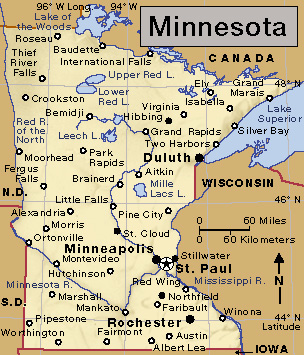

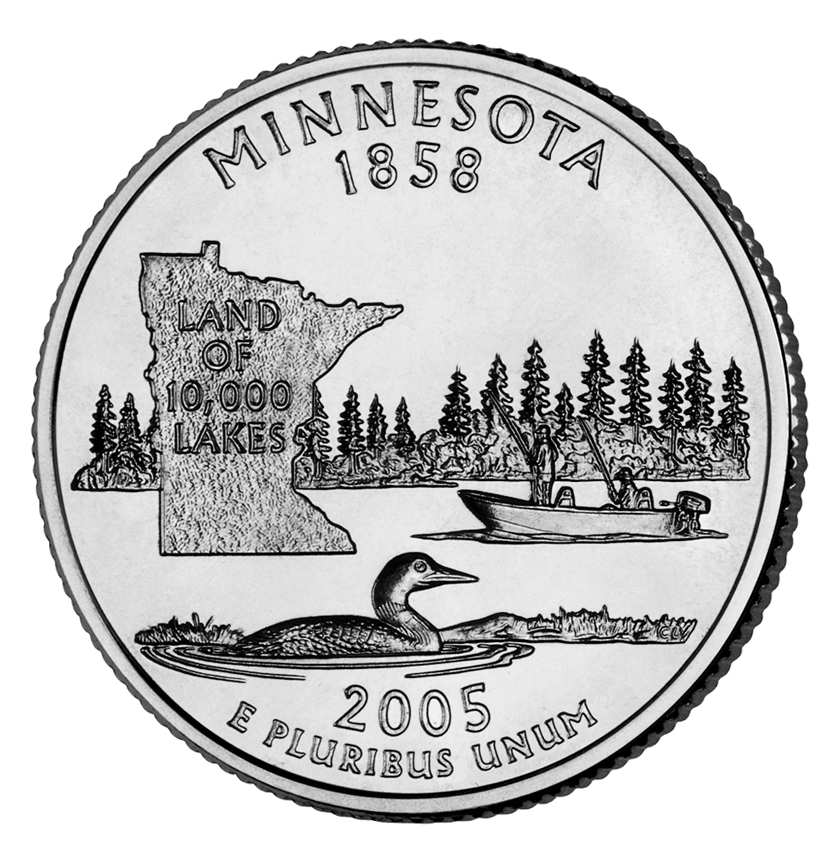
Southern Minnesota has some of the nation’s richest farmland. The state is a major producer of corn, dairy products, hay, hogs, oats, potatoes, soybeans, sugar beets, turkeys, and wheat.
The processing of farm products is a leading manufacturing activity in Minnesota. Large dairy plants, meat-packing plants, and a variety of food-processing plants are found in several parts of the state. The manufacture of computer components, medical devices, and other electronic products is also a major economic activity.
Minneapolis is a leading financial center of the Midwest. Retail trade employs many people in the Twin Cities. The Twin Ports of Duluth and Superior, Wisconsin, have one of the busiest freshwater ports in North America. The Mayo Clinic in Rochester is a world-famous medical center.
Minnesota’s scenic beauty, sparkling lakes, and deep pine woods make it a vacation wonderland. Its plentiful game animals and fish attract people who enjoy hunting and fishing. Campers, canoeists, and hikers can explore its vast northern wilderness areas.
The state’s history is much the story of the development of its great natural resources. The fur-bearing animals of Minnesota’s forests first attracted fur traders. Next, the fertile soil brought farmers, who poured into the region from the Eastern States and from Europe. The thick forests of tall pines attracted lumberjacks from Maine, Michigan, and Wisconsin. Finally, miners came to dig the state’s vast deposits of rich iron ore.
The name Minnesota means sky-tinted waters. It comes from the language of the native Santee, or Dakota, Sioux. Minnesota is called the Land of 10,000 Lakes. It is also known as the Gopher State. This nickname can be traced to an 1857 cartoon that represented dishonest railroad organizers as striped gophers. Gophers, known for being destructive to farm crops, live mainly in the state’s southern and western prairies.
People
Population.
The 2020 United States census reported that Minnesota had 5,706,494 people. The state’s population had increased 8 percent over the 2010 census figure, which was 5,303,925. According to the 2020 census, Minnesota ranks 22nd in population among the 50 states.
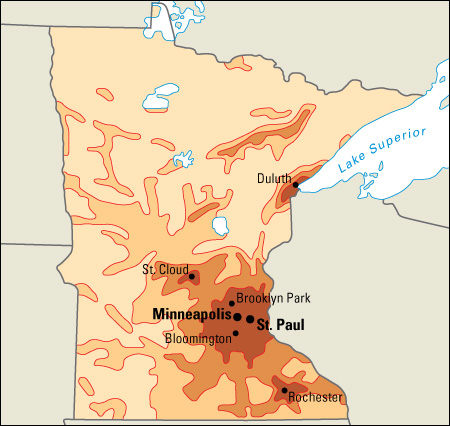
About 80 percent of Minnesota’s people live in one of the state’s nine metropolitan areas. About 60 percent of the people live in the Minneapolis-St. Paul-Bloomington metropolitan area (see Metropolitan area).
Minneapolis is the largest city in Minnesota. It adjoins St. Paul, Minnesota’s capital and second largest city. The Twin Cities, as they are called, serve as the state’s leading cultural, financial, and commercial center. The state’s next largest cities, in order of population, are Rochester, Bloomington, Duluth, Brooklyn Park, and Plymouth.
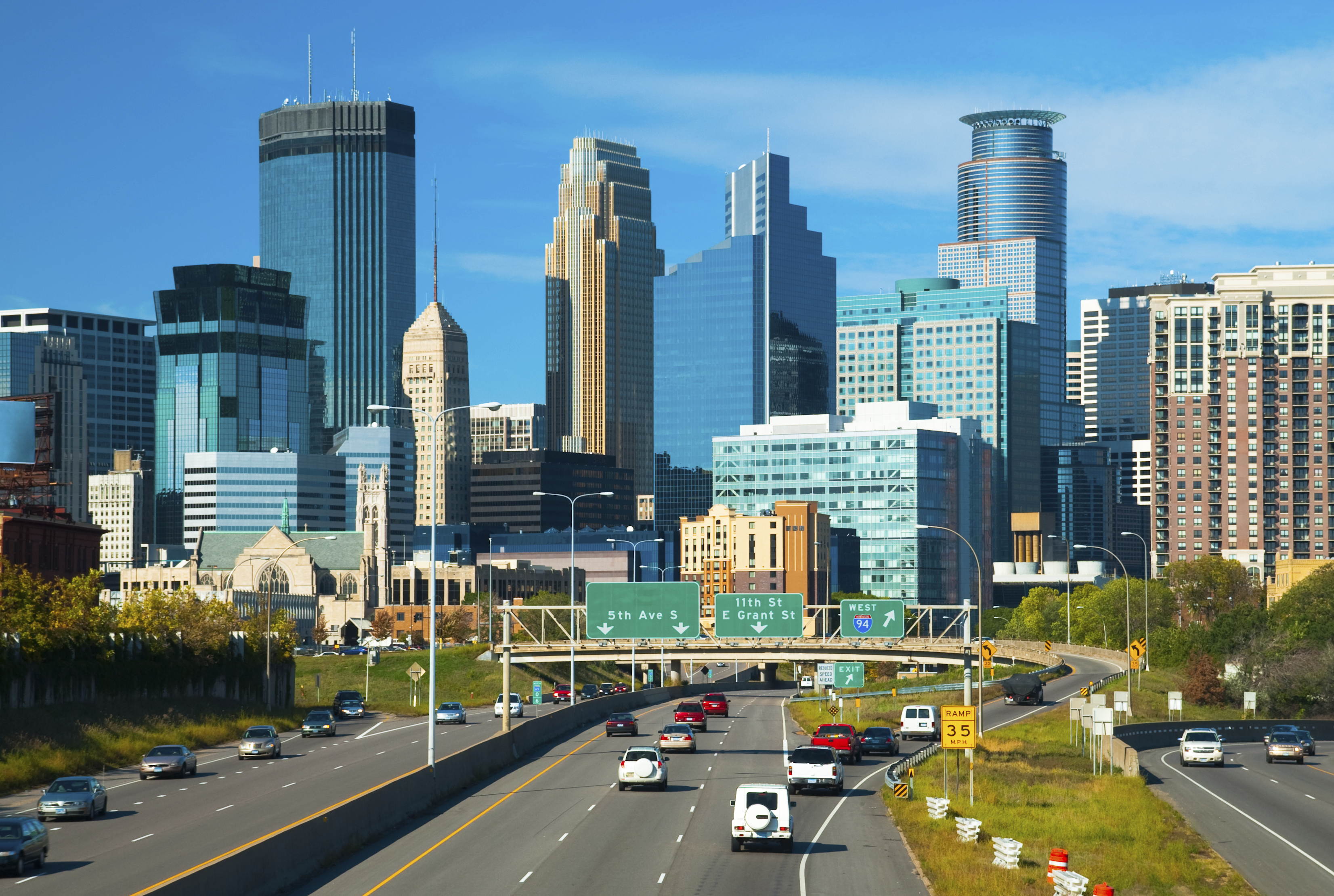
African Americans make up about 7 percent of Minnesota’s population. Hispanics account for about 6 percent and Asian Americans account for about 5 percent. Native Americans make up a little more than 1 percent of the population. The largest groups of people who settled in Minnesota during the 1800’s and early 1900’s came from Finland, Germany, Norway, and Sweden. Many also came from Austria, Canada, Denmark, Ireland, Poland, Russia, and the United Kingdom.
Schools.
About 1820, the first school for white children was opened at Fort St. Anthony (later renamed Fort Snelling). Missionaries set up some Native American schools during the 1830’s. In 1849, the territorial legislature passed a law providing for the establishment of public schools in Minnesota.
The Minnesota Department of Education oversees and supports school districts throughout the state. The governor appoints a commissioner to serve as chief administrator for the length of the governor’s term. Minnesota offers open enrollment across school districts. The state requires children to attend school between the ages of 7 and 16. The nation’s first charter schools opened in Minnesota in 1991. For the number of students and teachers in the state, see Education (table: U.S. students, teachers, and school expenditures).
Libraries.
The largest public libraries in Minnesota serve Minneapolis, St. Paul, and Hennepin County. The libraries of the Twin Cities Campus of the University of Minnesota have the largest collection in the state. The university has some of the country’s largest collections of materials dealing with children’s literature, European expansion, and Swedish Americana. It has hundreds of thousands of maps, which span 500 years.
Other important library collections in Minnesota include the Minnesota Historical Society Library and the Minnesota State Law Library, both in St. Paul; and the Mayo Clinic Libraries in Rochester. Statewide library networks allow Minnesotans to have access to materials from the state’s largest public and university libraries.
Museums.
The Minneapolis Institute of Art is the largest art museum in Minnesota. Its artworks come from many periods and cultures. The Walker Art Center in Minneapolis has an outstanding collection of modern art.
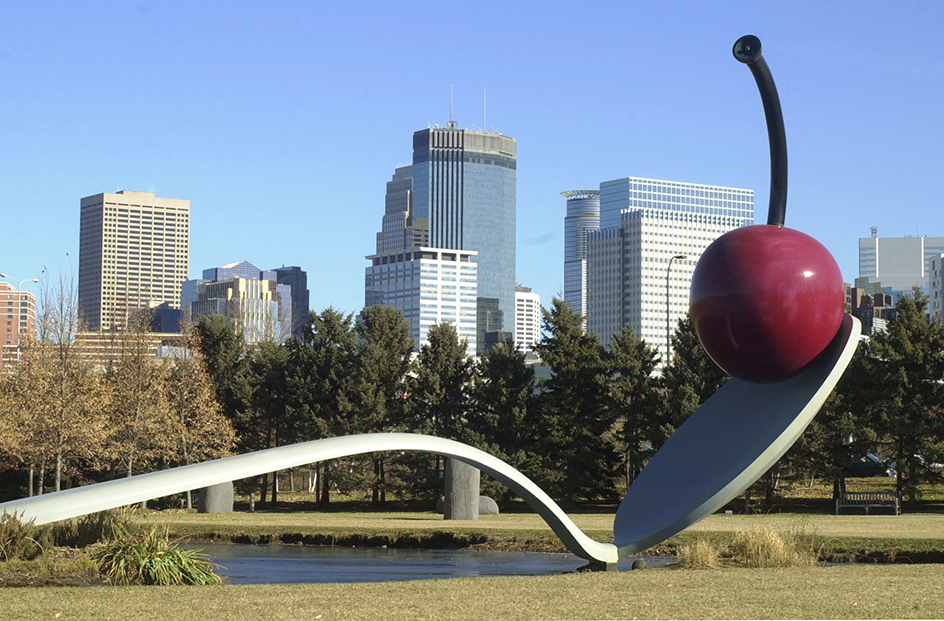
The Science Museum of Minnesota in St. Paul has exhibits dealing with science, technology, and natural history. The Lake Superior Railroad Museum in Duluth features railroad cars and equipment. The Lake Superior Maritime Visitor Center, also in Duluth, has displays of marine artifacts from the upper Great Lakes region.
Visitor’s guide
Minnesota is one of the nation’s most popular playgrounds. Every year, millions of residents and out-of-state visitors spend their vacations in Minnesota. The state offers such attractions as historic sites and museums, a gigantic shopping mall, and a wide variety of outdoor activities. Thousands of sparkling blue lakes attract swimmers, water skiers, and boaters. Fishing enthusiasts find the cool northern waters filled with a great variety of game fish. Golf courses and hiking and biking trails are plentiful. Wooded parks and deep forests are scattered throughout the state. Skiing, snowmobiling, and ice fishing are favorite winter activities.
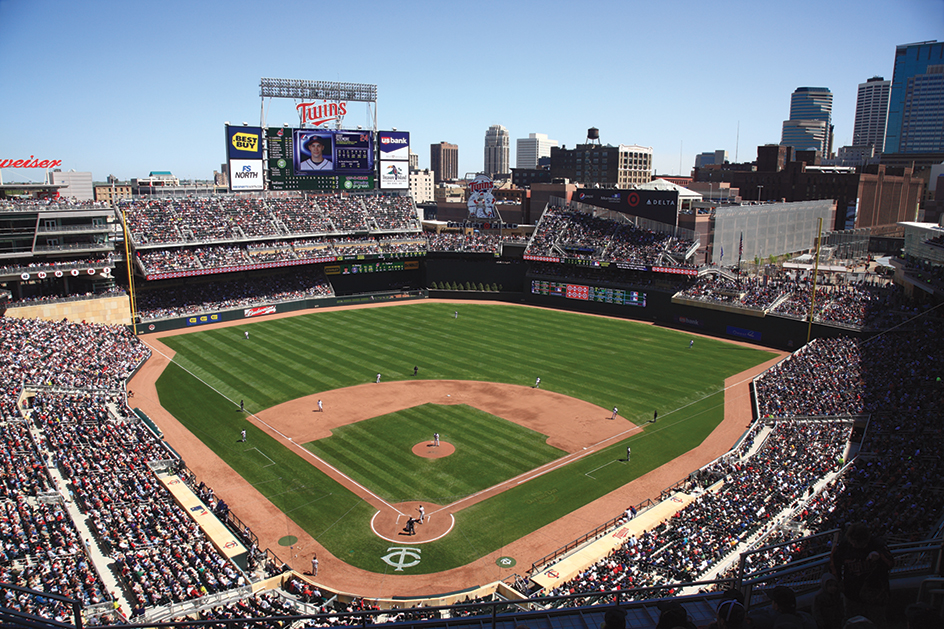
The state’s popular events include the St. Paul Winter Carnival, which begins in late January. The carnival includes ice-fishing tournaments and a snow-sculpting competition. The Minneapolis Aquatennial, held in July, features boat races, a sandcastle-building contest, a parade, and a fireworks show.
Land and climate
During a period of geologic time known as the Pleistocene Epoch, which ended about 11,500 years ago, a series of glaciers moved across Minnesota. As the glaciers advanced south and west, they leveled most of the land. Only a small area in the southeast was untouched. The glaciers created gently rolling plains over most of the state. Thousands of low places formed by the glaciers filled with water. These places became lakes, swamps, or marshes.
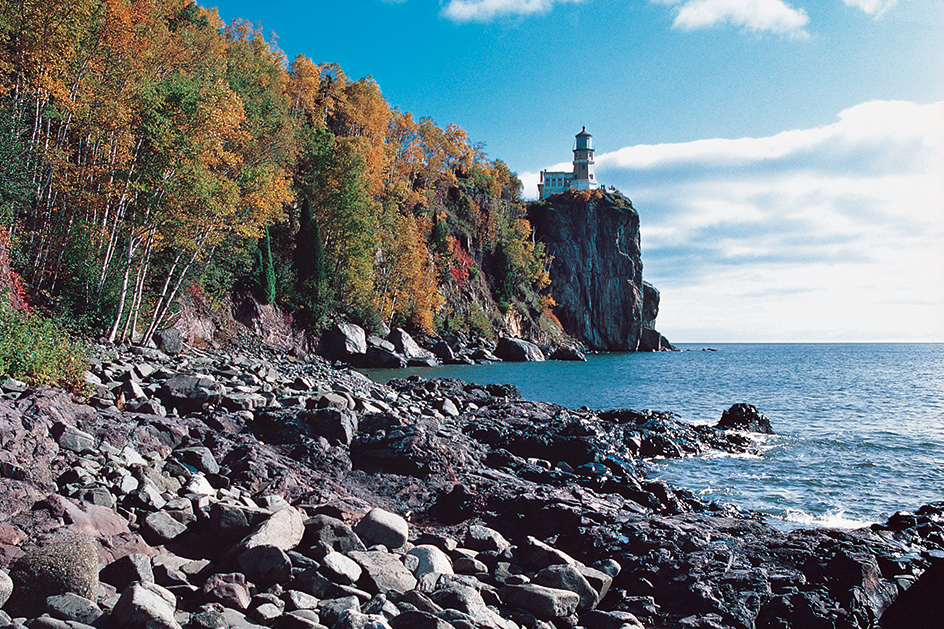
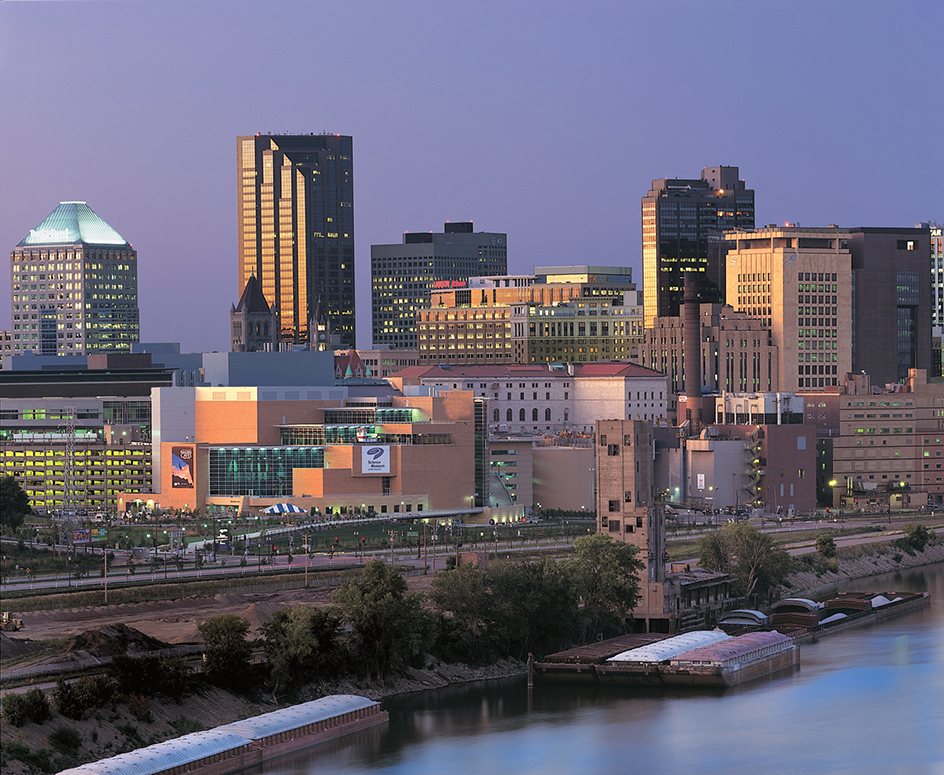
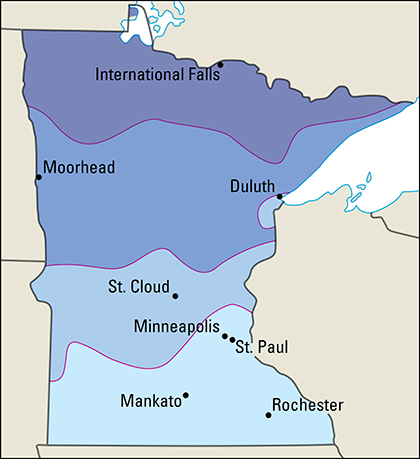
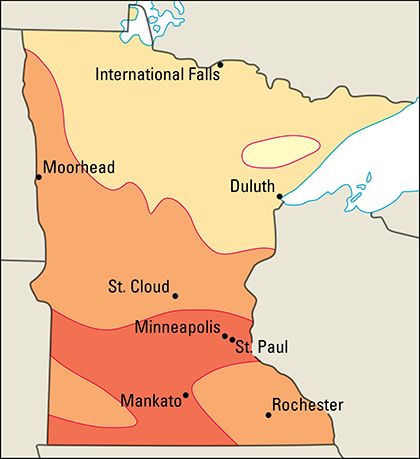
Land regions.
Minnesota has four major land regions: (1) the Northern Highland, (2) the Young Drift Plains, (3) the Dissected Till Plains, and (4) the Driftless Area.
The Northern Highland
is part of the southern tip of the Canadian Shield. Some geographers call this region the Superior Upland. The Canadian Shield is a vast area lying over old, hard rock (see Canadian Shield). The glaciers scraped the northeastern part of the Northern Highland and left exposed bedrock and little topsoil. Eagle Mountain, Minnesota’s highest point, is in this rugged area. It rises 2,301 feet (701 meters) in Cook County, in what is called the Arrowhead Country. Northeastern Minnesota has this name because it is shaped like an arrowhead.
The glaciers left moraines in the rest of the Northern Highland. Moraines are deposits of stones and other materials pushed before or along the sides of the glaciers. The moraines are mixed with flatter areas covered with wetlands. The Northern Highland has most of Minnesota’s iron ore deposits and many of its lakes.
The Young Drift Plains
consist mainly of gently rolling farmlands. Glaciers smoothed the surface of this region and deposited great amounts of fertile topsoil called drift as they melted. The region has some of the nation’s richest farmland, and it is the most important farming area in Minnesota. Parts of the Drift Plains are sandy or stony, and not so well suited for crop farming. Hilly moraine areas with many lakes can be found in some places, especially in central Minnesota. The northernmost tip of the Drift Plains was once part of the bed of Lake Agassiz, a huge lake that drained away after the end of Pleistocene Epoch (see Lake Agassiz). Marshlands and wooded areas lie in the eastern half of this section. The western part is a level, almost treeless plain.
The Dissected Till Plains
cover the state’s southwestern corner. There, the glaciers left a thick deposit of till—a soil-forming material of sand, gravel, and clay. Streams have dissected (cut up) the region. The few level areas in the Dissected Till Plains make excellent farmland. The Buffalo Ridge separates this region and the Young Drift Plains. The ridge is a watershed (divide between two river systems). It has also become an important site for generating wind power.
The Driftless Area
lies along the Mississippi River in the southeastern corner of the state. Geologists have found evidence that glaciers did cover much of this region hundreds of thousands of years ago. However, the Driftless Area went untouched during the most recent ice age. The western part is almost flat. Swift-flowing streams have cut deep valleys into the eastern part of the Driftless Area, giving it a broken surface.
Lakes, rivers, and waterfalls.
Minnesota has one of the greatest water areas of any state. Its thousands of inland lakes cover 4,782 square miles (12,385 square kilometers)—over a twentieth of the state’s area. The number of lakes in Minnesota has been estimated as high as 22,000. There are more than 15,000 known lake basins in the state that cover 10 acres (4 hectares) or more. But opinions differ on how large a body of water must be to be properly called a lake.
The largest lake within the state, Red Lake, covers 430 square miles (1,110 square kilometers) in northern Minnesota. Other big lakes in the northern part of the state include Cass Lake, Lake of the Woods, Leech Lake, Vermilion Lake, and Winnibigoshish Lake. Large lakes elsewhere in the state include Big Stone Lake and Lake Traverse, in western Minnesota; and Mille Lacs Lake and Lake Minnetonka, near the center of Minnesota.
Lake Itasca, in north-central Minnesota, is the source of the mighty Mississippi River. It flows out of the lake as a small, clear stream about 10 feet (3 meters) wide and less than 2 feet (61 centimeters) deep.
The Mississippi River and its branches drain about 57 percent of Minnesota. The Mississippi’s chief branches include the Crow Wing, Minnesota, Rum, St. Croix, and Sauk rivers. The Rainy River, the Red River of the North, and the Bois de Sioux River drain the northern and northwestern areas of Minnesota. The St. Louis River and other rivers that empty into Lake Superior drain the land that lies north of the lake.
One of the most beautiful waterfalls in the state is Minnehaha Falls, on Minnehaha Creek in Minneapolis. The American poet Henry Wadsworth Longfellow made this 53-foot (16-meter) falls famous in his poem The Song of Hiawatha (see Minnehaha Falls). The 49-foot (15-meter) Falls of St. Anthony, on the Mississippi River in Minneapolis, was an important source of power in the early development of Minneapolis. The highest waterfall entirely within the state is 124-foot (38-meter) Cascade Falls, on the Cascade River in Cook County. Another famous waterfall is High Falls, on the Pigeon River along the Minnesota-Ontario border. High Falls drops 133 feet (41 meters).
Plant and animal life.
Forests cover about one-third of Minnesota. Aspen, balsam fir, pine, spruce, and white birch grow in the north. Scattered groves of ash, black walnut, elm, maple, and oak grow in the south.
Blackberries, lilies of the valley, raspberries, rue anemones, wild geraniums, and wild roses are found in northern Minnesota. Blueberries, honeysuckles, sweet ferns, trailing arbutus, and wintergreen cover natural openings in the pine forests. Wildflowers grow in the southern, western, and northwestern parts of Minnesota. These flowers include asters, bird’s-foot violets, blazing stars, goldenrod, and prairie phlox.
White-tailed deer can be found over most of the state. Black bears, elk, moose, and timber wolves roam the woods and swamps of the north. Smaller animals found in various parts of Minnesota include beavers, bobcats, foxes, gophers, minks, muskrats, raccoons, and skunks. Quail and ring-necked pheasants feed in the grainfields. Ducks nest in the lakes and swamps during the summer. Fish in Minnesota waters include bass, northern pike, sunfish, trout, and walleye.
Climate.
In July, Minnesota averages 67 °F (19 °C) in the north and 72 °F (22 °C) in the south. The record high, 115 °F (46 °C), was set at Beardsley on July 29, 1917. January temperatures average 4 °F (–16 °C) in the north and 15 °F (–9 °C) in the south. The record low, –60 °F (–51 °C), was set at Tower on Feb. 2, 1996.
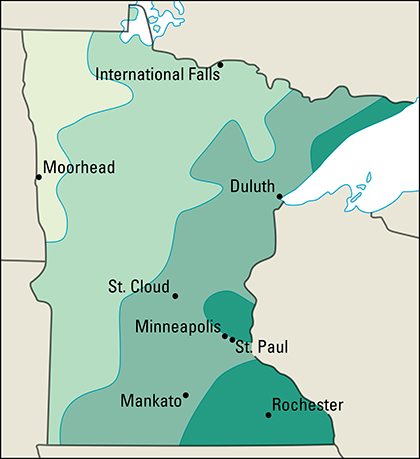
Northwestern Minnesota has about 20 inches (51 centimeters) of precipitation each year. The southeast receives over 32 inches (81 centimeters) of precipitation a year. Snowfall averages about 36 inches (91 centimeters) annually in the southwest and nearly 70 inches (180 centimeters) in the northeast.
Economy
Service industries, taken together, make up the greatest portion of Minnesota’s gross domestic product—the total value of all goods and services produced in the state in a year. Minnesota is internationally recognized as a center of health care and medicine. The state’s economy benefits from the tens of millions of tourists who visit each year. Manufacturing also plays an important role in the state’s economy.
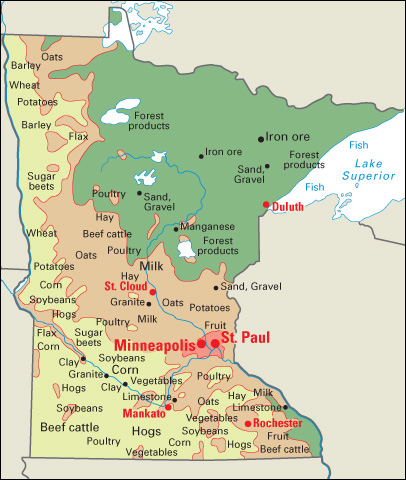
Natural resources
of Minnesota include fertile soil, important minerals, and thick evergreen forests.
Soil
is Minnesota’s most important natural resource because it is the basis of the state’s great farm economy. Minnesota has several types of soil. Most of them were formed from the drift deposited by the glaciers. The color and fertility of the soil indicate the direction from which the ice sheets came. Drift brought from the northwest was generally gray and more fertile. Drift from the northeast was reddish and less fertile. In some places, different kinds of drift were deposited in layers or mixed. In parts of southern Minnesota, the wind deposited a fine, silty material called loess on top of the drift. The loess formed a fertile, rock-free topsoil (see Loess).
Minerals.
The Mesabi Range, in St. Louis and Itasca counties, yields all of Minnesota’s iron ore. Most of the ore mined in the Mesabi Range comes from a rock called taconite (see Taconite). Ore from the Cuyuna Range, located just north of Mille Lacs Lake, contains manganese, an important element in steelmaking. Large deposits of granite are found near St. Cloud and along the upper Minnesota River. Quarries in the southern part of Minnesota produce limestone. Sand and gravel are found throughout the state.
Forests
cover about a third of Minnesota’s land. The most numerous trees in Minnesota are the balsam fir, black spruce, and quaking aspen. Trees found in the north include the black spruce, jack pine, red pine, tamarack, and white spruce. Eastern white pine and sugar maple trees are found in the east.
Service industries
provide the majority of Minnesota’s gross domestic product and employment. Most of these industries are in the Minneapolis-St. Paul area.
St. Paul, the state capital, is the center of government activities. Minneapolis is the headquarters of the Ninth Federal Reserve District Bank, one of the 12 federal banks established by Congress. Three of the nation’s top retailing companies, Best Buy, Target Corporation, and SuperValu Stores, are based in the Twin Cities area. The Twin Cities area is also home to many hotels, restaurants, and retail establishments.
The Mayo Clinic, one of the world’s largest medical centers, is in Rochester. The Twin Cities are home to several private health-care facilities and the University of Minnesota, a leader in organ transplants.
Manufacturing.
Food products are Minnesota’s leading manufactured product. Meat packing and dairy manufacturing are the most important food-processing activities. These activities are centered in the southern half of Minnesota. Minnesota is also a major state in the production of frozen foods and canned fruits and vegetables. Frozen food production is concentrated in the Minneapolis-St. Paul area. Most of the canned fruits and vegetables are produced in southern Minnesota. Sugar-beet refineries operate in the Red River Valley.
Computer and electronic products are also important. These products are primarily manufactured in the Twin Cities and Rochester areas. The state’s electronic products include medical devices developed by the state’s advanced health-care research facilities, which have many ties to the University of Minnesota.
The Twin Cities area produces agricultural and construction machinery and fabricated metal products. Fabricated metal products include machine shop products and weapons and ammunition. Petroleum refineries are in the St. Paul area. Paper and pulp mills are primarily in the northern half of the state. One of the world’s leading makers of snowmobiles and the off-road vehicles called all-terrain vehicles (ATV’s) is headquartered in Medina.

Agriculture.
Minnesota ranks among the leading states in annual farm income. Farmland covers about half the state.
Many Minnesota farmers sell their produce through farm cooperatives, groups of farmers who join to process, sell, and ship their products to get higher prices. Most of the cooperatives are dairy cooperatives. However, many of them handle grain and livestock.
Crops account for about three-fifths of Minnesota’s farm income. Corn is the most valuable field crop. Soybeans rank as the second most valuable crop. Minnesota is a leading state in the production of both corn and soybeans, which are primarily grown in central and southern Minnesota. Farmers also grow hay in the central and southern parts of the state. Minnesota is the leading state producer of sugar beets, mainly grown in the northern and western parts of the state. The Red River Valley of northwestern Minnesota is famous for its huge wheat crops.
Other field crops grown in Minnesota include barley, flaxseed, and oats. Beans, carrots, peas, potatoes, and sweet corn are the state’s leading vegetable crops. Apples are the leading fruit crop.
Livestock and livestock products provide about two-fifths of Minnesota’s annual income from farm products. Hogs are the state’s most valuable livestock product. Minnesota ranks among the leaders in hog production. The southern part of the state has the most hog farms. Dairy and beef cattle are also important sources of livestock income in Minnesota. Minnesota ranks as one of the leading milk-producing states. Much of Minnesota’s milk is made into cheese and ice cream. The state is also a leading producer of turkeys.
Mining.
Iron ore provides most of Minnesota’s mining income. Minnesota leads the states in iron ore production. But the importance of iron ore mining to the Minnesota economy declined greatly during the late 1900’s. Most of the remaining iron ore is a low grade called taconite. It is mined in northeastern Minnesota.
Quarries in central Minnesota yield unusually fine granite. Limestone is taken from extensive deposits in southern Minnesota. Sand and gravel are also produced throughout the state. Peat, partially decayed plant matter that has a variety of agricultural and commercial uses, is found mainly in the northern part of the state.
Fishing industry.
Fishing, both recreational and commercial, is a major activity in the state. The most valuable fishes taken from the Mississippi River include buffalo fish, carp, catfish, whitefish, and yellow perch. Lake herring, lake trout, smelt, walleye, whitefish, and yellow pike are the chief products of the Lake Superior catch.
Electric power and utilities.
Most of Minnesota’s electric power comes from nuclear plants, plants that burn coal or natural gas, and wind power. Minnesota has nuclear power plants at Prairie Island near Red Wing and at Monticello. Renewable resources also provide some of the state’s power.
Transportation.
Minnesota’s great network of rivers and lakes provided transportation for the explorers, fur traders, missionaries, and settlers who first entered the region. In the 1820’s, the first steamboats sailed on the upper Mississippi. Railroad construction in the state progressed rapidly after 1865. Today, the Twin Cities form the chief rail center of the Upper Mississippi Valley. They also have the state’s busiest airport.
Minnesota has an extensive system of roads and highways. The nation’s largest bus system, Greyhound Bus Lines, had its start in Hibbing in 1914, transporting iron miners to work.
Barges bring coal, oil, and other products to Minnesota ports which lie on the Minnesota, Mississippi, and St. Croix rivers. The barges return with grain and other products from Minnesota. Much of Minnesota’s water traffic is on Lake Superior. The harbor at Duluth and Superior, Wisconsin, is one of the busiest freshwater ports in North America. Coal, grains, and iron ore make up most of the outgoing cargo from this port.
Communication.
In 1849, James Madison Goodhue began publishing Minnesota’s first newspaper, the Minnesota Pioneer, in St. Paul. Today, the newspapers with the largest circulations include the Duluth News Tribune, the Star Tribune in Minneapolis, and the St. Paul Pioneer Press.
Government
Constitution.
Minnesota is still governed under its original constitution, adopted in 1857. The Constitution may be amended (changed) in two ways. An amendment may be proposed in the Legislature, where it must be approved by a majority of the lawmakers. Next, the amendment must be approved by a majority of the voters in an election.

The Constitution may also be amended by a constitutional convention. A proposal to call such a convention must be approved by two-thirds of the Legislature and by a majority of the voters in an election. Proposals made by a convention become law after they have been approved by three-fifths of the voters casting ballots on the proposals.
Executive.
Minnesota’s governor and lieutenant governor are elected as a team. They serve four-year terms and can be reelected any number of times. The secretary of state, attorney general, and auditor are also elected to four-year terms. The governor appoints the heads of most state departments, boards, and commissions. These officials are appointed to serve terms that range from two to six years.
Legislature
consists of a 67-member Senate and a 134-member House of Representatives. Each senator and representative is elected from a separate district. Most senators serve four-year terms. But senators elected in years that can be divided by 10 serve two-year terms to allow for reapportionment (redrawing of districts). All representatives serve two-year terms.
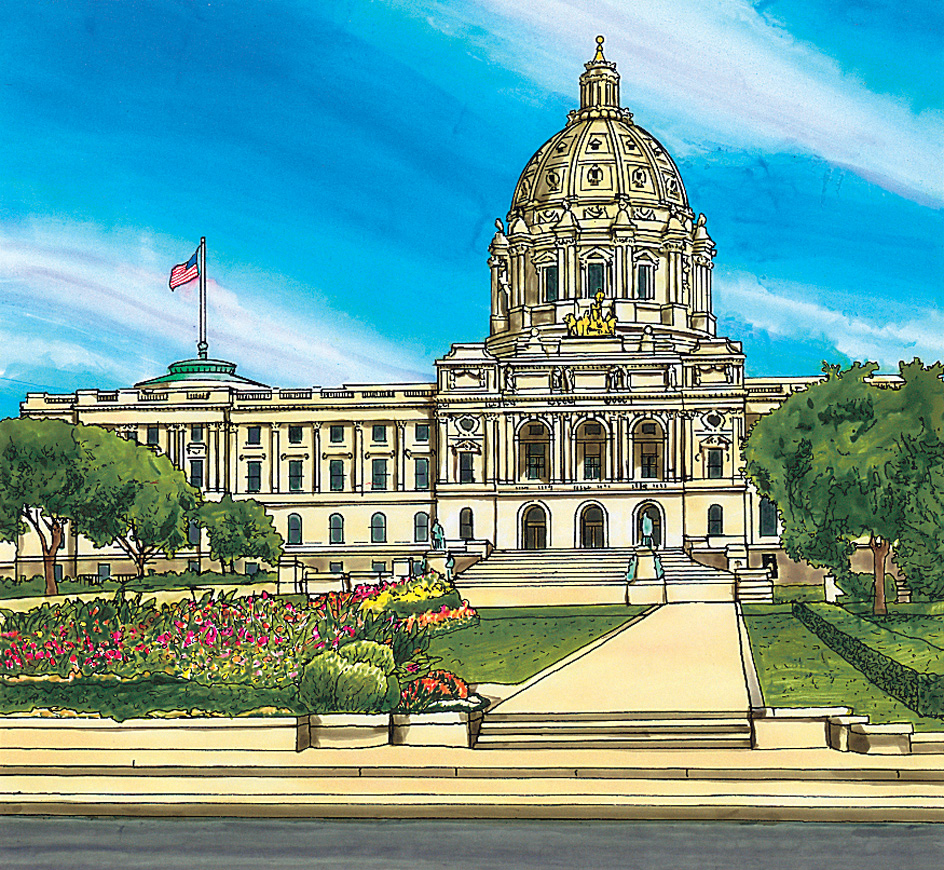
The Minnesota Legislature begins its regular session on the Tuesday after the first Monday in January in odd-numbered years. In even-numbered years, the session begins on a date agreed upon by both bodies. The Constitution of Minnesota limits regular legislative sessions to 120 legislative days over a two-year period. The governor may call special legislative sessions.
Courts.
The state Supreme Court, Minnesota’s highest court, has a chief justice and six associate justices. The chief justice and the associate justices are elected to six-year terms. The Court of Appeals consists of 19 judges, who are elected to six-year terms. Minnesota has one district court. It is divided into 10 judicial districts. Judicial district judges are elected to six-year terms. The district court handles criminal and civil cases. The judicial districts in Hennepin and Ramsey counties also handle cases involving juveniles.
Local government.
Minnesota has 87 counties. Each is governed by a board of commissioners, usually consisting of five members. The board’s powers include borrowing money, collecting taxes, and determining how funds are to be spent. Board members are elected to four-year terms. Other county officials in Minnesota include the attorney, auditor, medical examiner or coroner, sheriff, and treasurer. These officials also serve four-year terms.
Minnesota has hundreds of cities. The state constitution allows cities to adopt home-rule charters. This means that a city may choose the form of government best suited to its needs. Many cities operate under home-rule charters. Most Minnesota cities use the mayor-council form of government. The rest use the commission or council-manager form.
There are about 1,800 organized townships in Minnesota. Each township is governed by a board of supervisors. The voters elect the supervisors to three-year terms at an annual township meeting.
Revenue.
Taxes bring in about 60 percent of the state government’s general revenue (income). Most of the rest comes from federal grants and programs. A tax on personal income and a general sales tax provide most of the tax revenue. Other sources of tax revenue include taxes on corporate income, liquor, motor fuels, motor vehicle licenses, and tobacco.
Politics.
During most of its early history, Minnesota strongly favored Republicans over Democrats for state offices and for president. In 1918, a third party, the Farmer-Labor Party, was founded in Minnesota. It soon became powerful. In 1944, the Farmer-Labor Party joined with the Minnesota Democratic Party to form the Democratic-Farmer-Labor Party, also known as the DFL (see Farmer-Labor Party). Minnesota has generally favored Democratic presidential candidates since the 1930’s.
Hubert H. Humphrey, a DFL leader, served in the U.S. Senate from 1949 to 1964 and from 1971 to 1978. Humphrey was vice president of the United States from 1965 to 1969. He was the Democratic nominee for president in 1968, but he was not elected. Walter F. Mondale of Minnesota served as a U.S. senator from 1964 to 1976 and as vice president of the United States from 1977 to 1981. He was the Democratic nominee for president in 1984, but he lost the election.
In 1975, the Republican Party of Minnesota changed its name to Independent-Republicans of Minnesota. It changed the name back to Republican Party in 1995. Both the DFL and the Republicans have much strength in local Minnesota politics today.
History
Early days.
Europeans first entered the Minnesota region in the last half of the 1600’s. They found Santee, or Dakota, Sioux people in the northern forests. The Sioux lived in dome-shaped wigwams and were skilled hunters. By 1750, large numbers of Chippewa (also called Ojibwe) were moving westward into Minnesota. The Chippewa took over the northern forests of the region, and they forced the Sioux to move to the southwest. The Sioux became wanderers, and the two tribes remained enemies for many years. See Chippewa Indians; Sioux Indians.
Exploration.
Two famous French fur traders, Pierre Esprit Radisson and Médard Chouart, Sieur des Groseilliers, were the first Europeans to enter Minnesota. They arrived in the area near what is now Two Harbors, on Lake Superior, about 1660. See Groseilliers, Médard Chouart, Sieur des; Radisson, Pierre Esprit.
Another Frenchman, Daniel Greysolon, Sieur Duluth (or Du Lhut), arrived in 1679. Duluth was an adventurer who hoped to find a water route to the Pacific Ocean. He landed on the west shore of Lake Superior and then pushed on into the interior of Minnesota. He claimed the entire region for Louis XIV, the king of France. See Duluth, Daniel Greysolon, Sieur.
In 1680, Father Louis Hennepin, a Belgian missionary, set out from the Illinois region to explore the upper Mississippi. But Sioux warriors captured Hennepin and his two companions. They took them into Minnesota. Although a captive, Hennepin saw much of the region. He became the first European to visit the site of present-day Minneapolis, where he sighted and named the Falls of St. Anthony. Meanwhile, Duluth heard that several Sioux had captured three white men. He found the group and successfully demanded that they release the captives. See Hennepin, Louis.
Struggle for control.
In 1762, France gave Spain all its land west of the Mississippi River, including much of Minnesota. But the Spaniards did not try to explore or settle the region, and French trappers continued to collect furs there. In 1763, the French and Indian War ended. France lost this war with the United Kingdom over rival claims in North America. France gave the United Kingdom almost all its land east of the Mississippi, including eastern Minnesota. During the next 50 years, the North West Company and other British fur-trading firms established posts in the region.
In 1783, the Revolutionary War in America ended. The United Kingdom gave its land that was south of the Great Lakes and east of the Mississippi River to the United States. This vast area became part of the Northwest Territory, which the U.S. Congress created in 1787. However, British fur companies continued to trade in the region. The United States did not gain full control of the Northwest Territory until after the War of 1812.
The Louisiana Purchase.
In 1800, Napoleon Bonaparte forced Spain to return the region west of the Mississippi River to France. France sold this region, called Louisiana, to the United States in 1803 (see Louisiana Purchase). Two years later, Zebulon M. Pike was sent to explore the upper Mississippi and the Minnesota wilderness.
In 1819, the U.S. Army established a fort in temporary buildings in southeastern Minnesota, at the point where the Minnesota and Mississippi rivers meet. In 1820, American soldiers began building Fort St. Anthony as a permanent fort there. The fort was completed in 1825 and renamed Fort Snelling. It became a center of industry and culture as well as a military post. Explorers often used Fort Snelling as a base from which they set out for undiscovered parts of Minnesota. These explorers included Stephen H. Long, William H. Keating, and George W. Featherstonhaugh. In 1832, Henry R. Schoolcraft discovered and named Lake Itasca, the source of the Mississippi River.
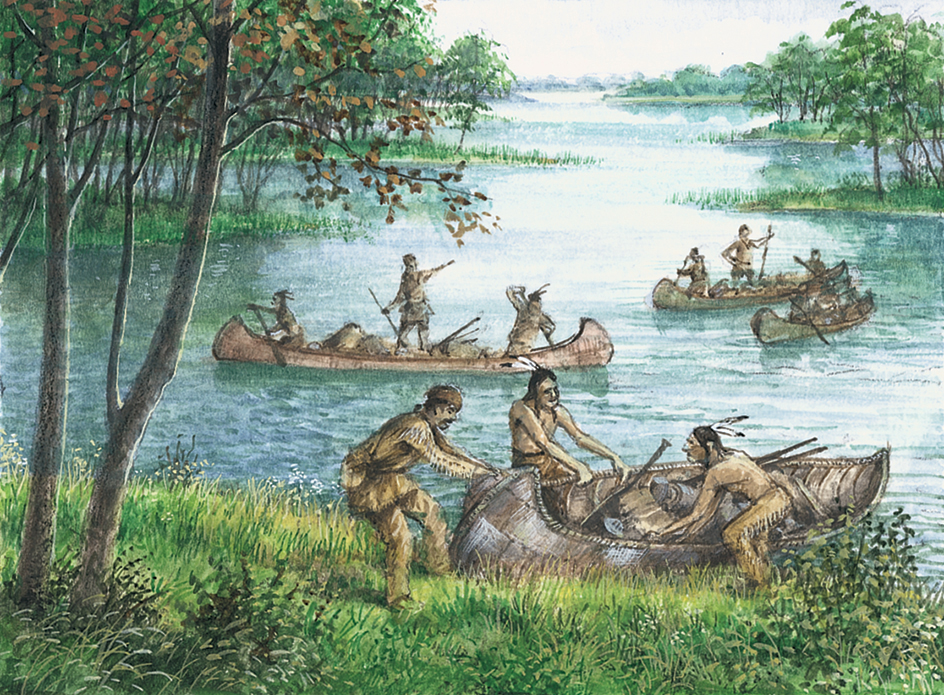
Lumbering began in the St. Croix Valley during the late 1830’s. In 1837, the Sioux and Chippewa sold their claims to the logging area around the St. Croix River to the U.S. government. Lumberers and settlers soon moved to the area. Settlers founded Minnesota’s first towns—Stillwater, St. Paul, and St. Anthony (which later merged with Minneapolis).
Territorial days.
Through the years, parts of Minnesota had belonged to the territories of Illinois, Indiana, Iowa, Michigan, Missouri, and Wisconsin, and to the territory and district of Louisiana. On March 3, 1849, Congress created the Minnesota Territory. Its southern, northern, and eastern boundaries were the same as those of the state today. The western boundary extended to the Missouri and White Earth rivers. Alexander Ramsey was appointed as the first territorial governor. About 4,000 white people lived in Minnesota when it became a territory.
In 1851, the Sioux people, under pressure from the U.S. government, signed two treaties giving up their rights to a vast area west of the Mississippi River. Most of the land was in southern Minnesota. This new rich territory was opened to white settlement, and newcomers poured in.
Statehood.
On May 11, 1858, Congress admitted Minnesota into the Union as the 32nd state. Minnesota voters elected Henry H. Sibley as the first governor of their state. Sibley had been an agent of the American Fur Company and had worked for the creation of the Minnesota Territory. Minnesota had a population of about 150,000 when it became a state.
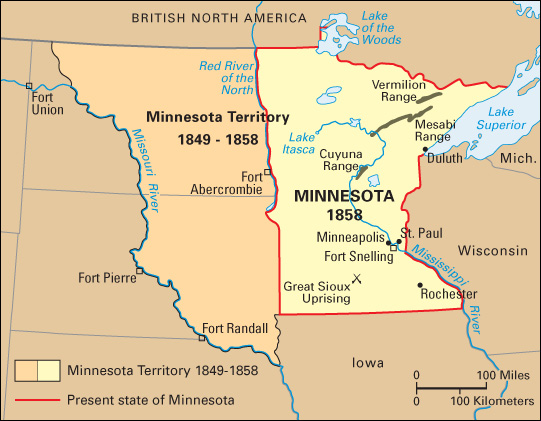
The American Civil War began in 1861. Minnesota became the first state to offer troops for the Union armies. In August 1862, what came to be called the Great Sioux Uprising, or the Dakota Conflict, occurred. The Sioux, crowded onto a reservation and near starvation, began attacking settlers. Hundreds of settlers were killed before the state militia ended the fighting. Many Sioux fled the area, and 38 were later hanged in a mass execution. The remaining Sioux were moved from Minnesota to other reservations.
Industrial development
occurred rapidly in Minnesota after the Civil War ended in 1865. Railroads expanded across the state, and the old Sioux hunting grounds became wheat lands. Flour mills sprang up throughout the wheat region, but most were in the Minneapolis area. Minneapolis became known as the Mill City and was the nation’s leading flour producer from the 1880’s to the 1930’s.
Minnesota waged a vigorous drive to attract newcomers. The state government and the railroads sent pamphlets to Europe, describing the opportunities in Minnesota. During the 1870’s, 1880’s, and 1890’s, thousands of immigrants, especially Germans, Norwegians, and Swedes, settled in the state.
The outstanding event of the late 1800’s was the development of rich iron ore resources. In 1884, the first ore was shipped from the Vermilion Range. In 1890, workers employed by Leonidas Merritt and several of his seven brothers discovered ore near Mountain Iron in the Mesabi Range. Two years later, after involving other relatives in their venture, the Merritts shipped the first load of ore from the Mesabi Range.
In 1889, William W. Mayo and his two sons, William and Charles, established the Mayo Clinic in Rochester. The clinic’s fame spread rapidly, and the Mayos turned it into a general medical center. The clinic became one of the world’s leading medical research centers. See Mayo Clinic.
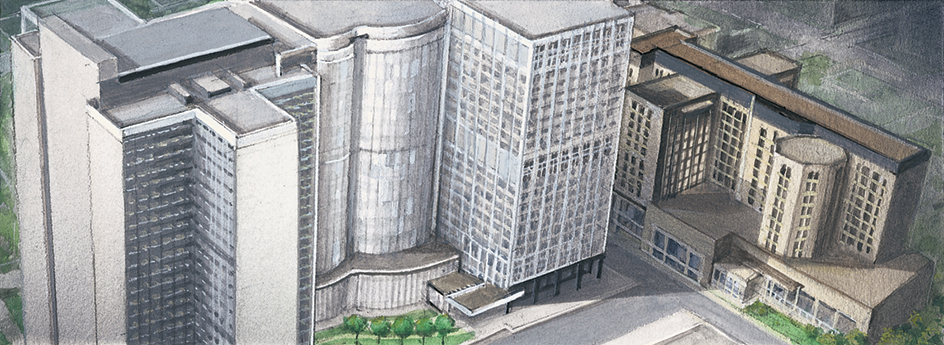
In 1894, a great forest fire swept across about 400 square miles (1,000 square kilometers) of eastern Minnesota. It wiped out the villages of Hinckley and Sandstone. More than 400 people were killed, and property valued at over $1 million was destroyed.
The early 1900’s.
In 1911, the first shipment of iron ore left the Cuyuna Range. In December 1915, the first operations began at a huge steel mill in Duluth. After the United States entered World War I in 1917, there were heavy demands for Minnesota’s products. Great crops of wheat and other grains were raised to feed the armed forces. Iron ore production totaled almost 90 million short tons (82 million metric tons) during 1917 and 1918.
In 1918, Minnesota was struck by another disastrous forest fire. Strong winds fanned a number of small fires into one huge fire that roared across large areas of Carlton and St. Louis counties in the northeast. The fire killed more than 400 people and destroyed property valued at about $25 million.
During the 1890’s and early 1900’s, many Minnesota farmers joined cooperatives. They joined together to provide their own financial and storage services, and transportation for their products. The farmers believed that the railroads, banks, and grain companies charged too much for these services. During the 1920’s, the new Farmer-Labor Party supported the farmers. In 1931, Floyd B. Olson became the first Farmer-Labor governor.
The Great Depression of the 1930’s hit Minnesota hard. Unemployment was widespread in the cities. About 70 percent of the iron-range workers in the state lost their jobs. Farm income, which had started to fall in the late 1920’s, continued to fall. The state government took many steps to fight the Depression, and federal agencies were set up to provide employment and relief.
The mid-1900’s.
Minnesota’s economy recovered during World War II (1939-1945). The state’s lumber and mining industries turned out huge amounts of raw materials for the armed forces. But the supply of high-grade iron ore suddenly dropped in the late 1950’s, as did the demand for the ore. The industry declined and several mines closed. As a result of the mining slump, the state’s iron industry began to develop low-grade taconite ore. Taconite contains from 17 to 35 percent iron in the form of specks of iron oxide.
In 1964, Minnesota voters approved an amendment to the state constitution that boosted investment in the iron industry. The so-called taconite amendment guaranteed that taxes on taconite would not be raised at a higher rate than taxes on other products for 25 years. Previously, iron-mining companies had been taxed at a higher rate, and producers had delayed plans to build taconite plants. After passage of the taconite amendment, producers invested more than $1 billion in taconite plants.
Many new manufacturing industries began operating in Minnesota during the mid-1900’s. The products of these industries include aerospace equipment, chemicals, computers, electronic equipment, and heavy machinery. These developments added diversification (variety) to the state’s economic base.
In Minnesota, as in other states, the number of farms and farmworkers decreased. Large numbers of families moved from rural areas to cities. By 1950, the state’s total urban population had grown larger than the rural population for the first time. In 1964, a federal court ordered Minnesota to reapportion (redivide) its legislative districts to give the city population equal representation in the state Legislature.
The Farmer-Labor Party joined the state Democratic Party in 1944 to form the Democratic-Farmer-Labor Party (DFL). In 1975, the Republican Party of Minnesota changed its name to Independent-Republicans of Minnesota. It changed the name back to Republican Party in 1995.
The late 1900’s.
The state’s taconite plants became a source of air and water pollution. In 1978, the Minnesota Supreme Court ordered the Reserve Mining Company of Silver Bay to meet pollution control standards at its taconite-processing plant. In 1980, the company established an on-land waste disposal site and no longer discharged waste into nearby Lake Superior. In the 1980’s and 1990’s, the state government worked with businesses to have the businesses increase their own pollution control efforts.
The economic diversification that began in Minnesota during the mid-1900’s increased in the 1990’s. The growth of service industries such as finance, insurance, and real estate contributed to the state’s economic strength. The production of medical devices played an expanding role in the manufacturing sector.
The early 2000’s.
Minnesota voters had elected Jesse Ventura governor in 1998. Ventura was the first Reform Party candidate in the United States to win a statewide office. Ventura left the Reform Party in 2000 and became an independent. He did not run for reelection, and his term ended in 2003.
A light rail system began operating in Minneapolis in mid-2004. It was the state’s first light rail system.
On Aug. 1, 2007, a section of the Interstate 35W bridge across the Mississippi River in Minneapolis collapsed, sending dozens of vehicles into the river. Thirteen people were killed, and more than 100 were injured. Officials said the 40-year-old steel-truss bridge likely collapsed because of a number of factors, including corrosion, vibrations, weathering, and weight. In November 2008, however, investigators said that a design flaw in the bridge had led to its collapse. In November 2007, construction began on a replacement bridge. The new bridge was completed in September 2008.
In 2008, a U.S. Senate race in Minnesota was so close that the result remained unknown months after the November 4 election. The initial results showed a difference of only a few hundred votes between the two candidates, Republican Senator Norm Coleman and his Democratic challenger, author and comedian Al Franken. In January 2009, after a recount of votes required by Minnesota law, election officials declared Franken the contest’s winner. However, Coleman filed a lawsuit challenging the recount’s results in court. In April, a three-judge panel dismissed Coleman’s argument that the election had been conducted unfairly. The panel recommended that Franken be certified the winner of the election, but Coleman appealed the ruling to the state Supreme Court. In June, the Minnesota Supreme Court ruled that the recount results were valid and declared Franken the winner of the Senate contest.
Many state government operations shut down for about three weeks in 2011. Democratic Governor Mark Dayton and Republican legislative leaders failed to agree on a new two-year state budget by July 1, triggering the shutdown. Later in July, Dayton signed a budget agreement that aimed to reduce the state’s large deficit. Minnesota government operations returned to normal.
